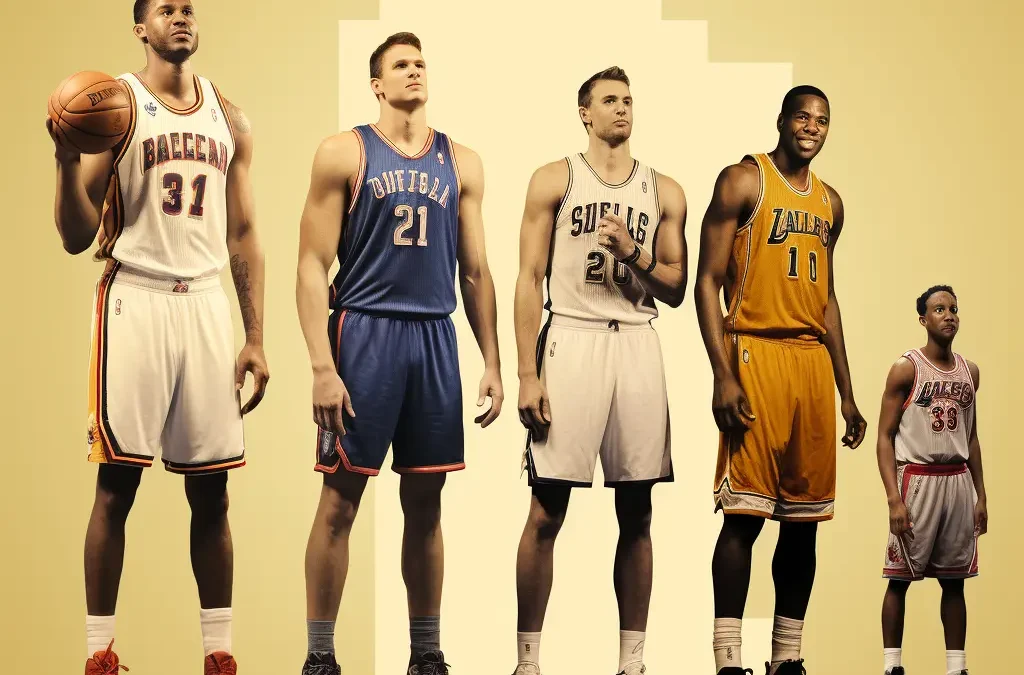Huddle In For Decoding the Evolution of Average Height in the NBA
When we watch basketball games, we’re often left in awe of the players’ extraordinary speed and agility on the court. These athletes seem to move effortlessly, despite their impressive height. Indeed, basketball players are some of the tallest individuals in the world, and their ability to maneuver with such grace is a testament to their remarkable athleticism.
The National Basketball Association (NBA) stands as a testament to this phenomenon. Traditionally, each position in a basketball team was thought to be represented from the shortest to the tallest player. However, as the sport has evolved, these preconceived notions have been shattered, giving rise to a new era of versatility and adaptability on the court.
Kobe Bryant’s top 5 plays while wearing No. 24! #KobeDay
— NBA (@NBA) August 24, 2023
pic.twitter.com/6LruHoLdIa
The NBA Landscape and Positional Breakdown
Before we delve into the evolution of player heights, let’s understand the foundation of the NBA. In basketball, teams are categorized based on five positions: point guards, shooting guards, small forwards, power forwards, and centers. These positions are not merely titles; they define the roles and responsibilities of players on the court.
Historically, positions were often identified by the height of the players. Point guards were typically the shortest, followed by shooting guards, small forwards, power forwards, and centers. This traditional categorization seemed like a reliable pattern, but as the game evolved, it revealed that talent knows no height.
Please note that Huddlecourt and its content providers may receive compensation for some links to products and services featured on this website. Rest assured that we have handpicked these products to provide you with the best options available.
Breaking Stereotypes: Height Evolution in the NBA
As the years have progressed, we’ve witnessed an intriguing shift in player heights across positions. This evolution challenges the notion that certain positions must adhere to specific height requirements. It’s a fascinating phenomenon that mirrors the changing nature of the sport itself.
So, why has this evolution occurred? One contributing factor is the advancement in training techniques and the accessibility of nutritional resources. Today’s players benefit from cutting-edge technology that aids in their development. The NBA has become a realm where players are not confined by traditional expectations, and they are reshaping the game as a result.
Analyzing Position by Position
Let’s embark on a journey through each position, unraveling the heights that players of different eras have brought to the court:
Average NBA Point Guard Height
Point guards, often considered the shortest players, were once around 6’0″ in the 1952 NBA season. However, as the game embraced change, the average height of point guards increased to 6’3″, exemplified by towering players like Magic Johnson and Ben Simmons.
Average NBA Shooting Guard Height
Shooting guards, slightly taller than point guards, now stand between 6’3″ to 6’6″. This position witnessed a shift, thanks to legends like Michael Jordan and Kobe Bryant, who popularized the shooting guard role.
Average NBA Small Forward Height
Small forwards, often described as versatile players, now boast an average height of 6’6″ to 6’10”. Their ability to guard multiple positions and score from various areas on the court makes them integral to team success.
Average NBA Power Forward Height
The average height of power forwards, traditionally closer to small forwards, hovers between 6’8″ to 6’11”. Notably, power forwards have evolved to embrace the three-point shot, adding a new dimension to their game.
Average NBA Center Height
Centers, historically the tallest players, maintain their stature with an average height that towers above the rest. While the game has shifted to emphasize perimeter shooting, centers remain indispensable with their rebounding, defensive prowess, and post-up skills.
More Basketball Content on Huddlecourt
Click here to read more and discover why the NBA is taking the basketball world by storm. Let the excitement begin!
Impact on Team Dynamics
One of the remarkable aspects of the NBA is how teams blend players of varying heights to create a cohesive unit. A successful team is a symphony of skills, with each position contributing its unique melody. This mix of heights and abilities forms the backbone of a winning team.
The versatility that players bring to their positions ensures that a team can adapt to various scenarios on the court. Point guards orchestrate plays, shooting guards excel in long-range shooting, small forwards offer balance, power forwards dominate both inside and outside, and centers anchor the defense and rebounding.
Historical Milestones and Iconic Players
The history of the NBA is adorned with players who defied height norms to become icons of the game. Magic Johnson’s towering presence as a point guard and Michael Jordan’s aerial acrobatics as a shooting guard revolutionized basketball. Kobe Bryant’s tenacity, LeBron James’s all-around brilliance, and the finesse of players like Larry Bird and Scottie Pippen remain etched in basketball lore.
The Future of NBA Player Heights
As the NBA continues to evolve, the trajectory of player heights will likely follow suit. The influence of science, technology, and evolving player preferences will shape the landscape of the game. One can only speculate how the positions and heights we know today might evolve in the years to come.
Please note that Huddlecourt and its content providers may receive compensation for some links to products and services featured on this website. Rest assured that we have handpicked these products to provide you with the best options available.
Huddle Wrap-Up On The Average Height In The NBA
The average height of NBA players tells a captivating story of adaptation, innovation, and breaking boundaries. While height remains a significant factor, the evolving game reveals that talent, skill, and determination transcend mere inches. As we witness players redefine positions and rewrite records, one thing is clear: basketball’s allure lies in its ability to surprise and inspire, regardless of height.
Thank you for joining us on this journey through the evolution of average height in the NBA. The sport’s history is a testament to the ever-changing nature of human potential and the indomitable spirit of those who grace the hardwood.
Follow along for many more exciting conent on Huddlecourt.
Complete list of NBA players bio data can be found at NBA official homepage.
Frequently Asked Questions
Have more questions about the heights of NBA players? Here are answers to some common queries:
-
What Is The Most Common And Average Height In The NBA?
The most common NBA players’ height is roughly around 6’7″ or 2.01m, and this happens to be most common in the Small Forward position. Height plays a significant role in a player’s potential and skill, often translating to better performance in the sport. -
How Do NBA Players Record Their Height?
In the current 2022-2023 NBA season, the average NBA player height is roughly around 6’6″ tall (or 198.6cm). NBA teams now record players’ actual height numbers by their team doctors without shoes, aiming for more accurate measurements and avoiding any height-related politics. -
Who Were The Shortest And Tallest Players To Ever Play In The NBA?
Throughout NBA history, there have been standout players at both ends of the height spectrum. The shortest player to ever play in the NBA was Muggsy Bogues, standing at just 5’3″, while the tallest player was tied between Gheorghe Mureșan and Manute Bol, both measuring a towering 7’7″.
We hope these answers provide a deeper understanding of the fascinating world of NBA player heights.




